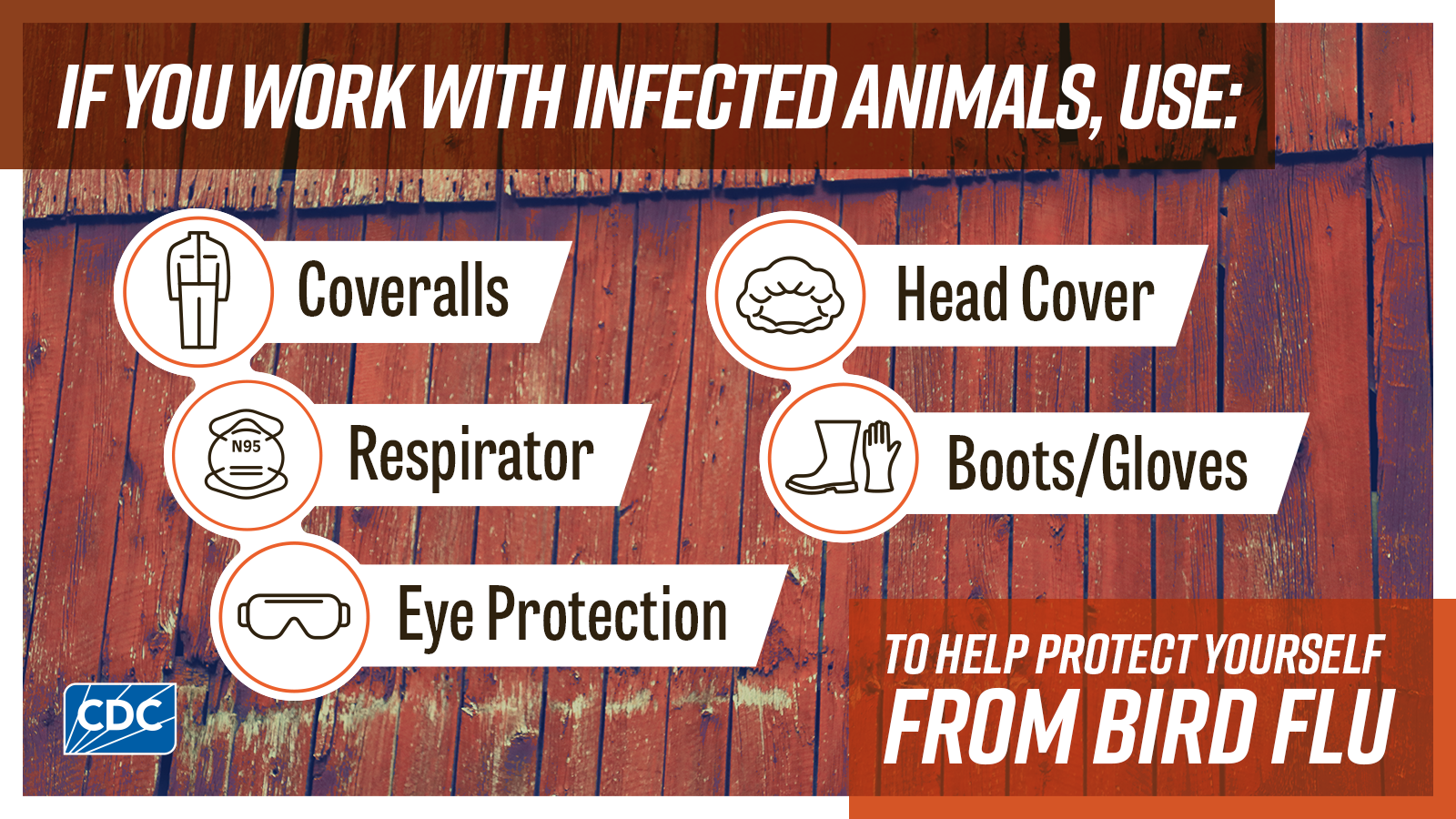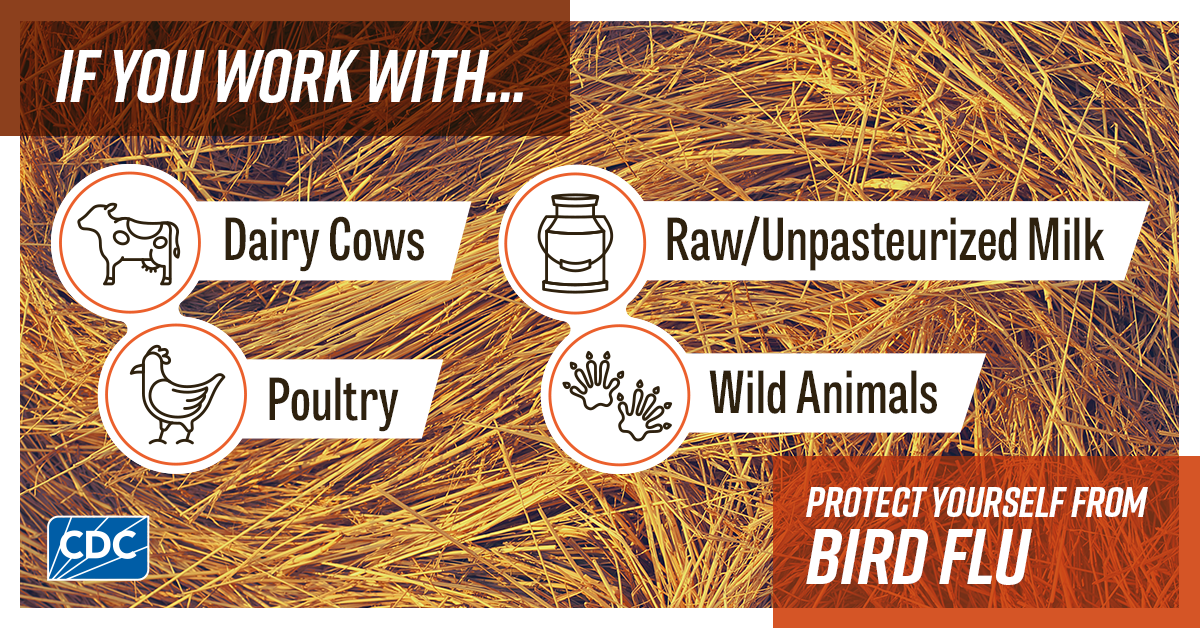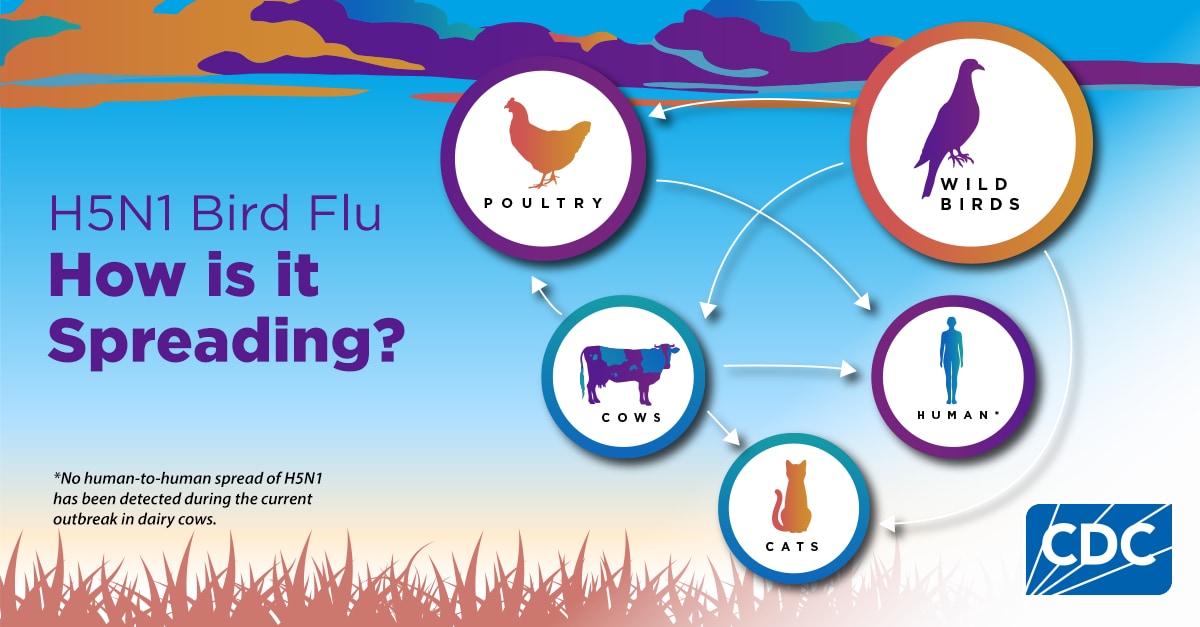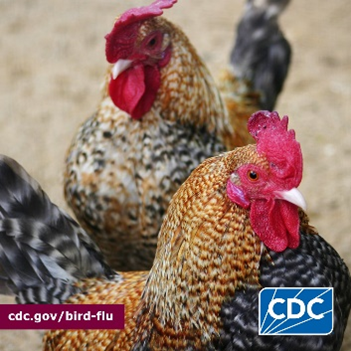Purpose
CDC's avian influenza (bird flu) social media toolkit is available to help communicate about bird flu prevention. This digital toolkit includes sample social media copy and associated graphics.
How to use this toolkit
The following social media messages and graphics are organized by audience and topic. To share these messages on your channels, download the images and post them with the accompanying message.
For general audiences
X message: Symptoms
H5N1 bird flu is spreading in some farm animals like poultry and cows. Though rare, it can infect people.
If you are around poultry, dairy cows, or raw, unpasteurized milk, seek medical care if you get symptoms of bird flu:
- Eye Redness
- Fever
- Cough
- Sore Throat
- Muscle Aches
- Shortness of Breath
Find out more about the signs and symptoms of bird flu at https://www.cdc.gov/bird-flu/signs-symptoms/index.html

X Message: Symptoms (Spanish version)
La influenza aviar H5N1 se está propagando en algunos animales de granja, como aves de corral y vacas. Aunque es raro puede infectar a las personas. Si estás cerca de aves de corral, vacas lecheras o leche cruda sin pasteurizar, busca atención médica si tienes síntomas de influenza aviar:
- Enrojecimiento de los ojos
- Fiebre
- Tos
- Dolor de garganta
- Dolores musculares
- Dificultad para respirar
Entérate más sobre los signos de la influenza aviar en https://espanol.cdc.gov/bird-flu/signs-symptoms/index.html

For employers of people working with animals
X message: Levels of exposure to bird flu
CDC recommends three levels of controls for workers exposed to animals with H5N1 bird flu. A worker's exposure level could be low, medium, or high depending on their task and setting.
Find out more about exposure levels: https://www.cdc.gov/bird-flu/worker-safety/personal-protective-equipment.html

Facebook or LinkedIn message: Exposure controls
CDC recommends three levels of controls for workers exposed to animals with H5N1 bird flu. Employers: Consult CDC guidance to determine the exposure level based on work setting and tasks.
Exposure level depends on factors, such as:
- Work with animals or animal secretions (such as raw milk)
- Presence of H5N1 confirmed or possibly infected animals
- Distance from a farm with H5N1 infected animals
Find out more about exposure controls: https://www.cdc.gov/bird-flu/worker-safety/personal-protective-equipment.html

Facebook or LinkedIn message: Levels of PPE
To help employers best protect workers exposed to animals with H5N1 bird flu, CDC has recommendations for three levels of exposure: low, medium, and high. Find more on the personal protective equipment (PPE) workers need for each level of exposure at https://www.cdc.gov/bird-flu/worker-safety/personal-protective-equipment.html

For people working with animals
X message: Ask your supervisor about protective gear
If you work with animals confirmed or potentially infected with H5N1 viruses, talk to your supervisor to understand your level of exposure to H5N1 bird flu and what personal protective equipment (PPE) you should wear to protect yourself. Learn what steps you can take: https://www.cdc.gov/bird-flu/prevention/farm-workers.html

X message: Ask your supervisor about protective gear (Spanish version)
Si trabajas con animales con infección por el virus H5N1, ya sea confirmada o potencial, habla con tu supervisor para saber tu nivel de exposición a la influenza aviar H5N1. Pregunta cuál equipo de protección personal (EPP) deberías usar para protegerte. Conoce las medidas que puedes tomar: https://espanol.cdc.gov/bird-flu/prevention/farm-workers.html

X message: Protective gear
#H5N1 #birdflu is spreading in some farm animals like poultry and cows. Though rare, bird flu can infect people who are around these animals.
Use protective gear when working with H5N1 virus-infected poultry, dairy cows or other animals:
- Coveralls
- NIOSH® Approved respirator
- Goggles or eye protection
- Head cover
- Boots
- Gloves
Learn the steps to stay safe: https://www.cdc.gov/bird-flu/prevention/farm-workers.html

X message: Protective gear (Spanish version)
La influenza aviar H5N1 se está propagando en algunos animales de granja, como aves de corral y vacas. Aunque es raro, la influenza aviar puede infectar a las personas cerca de ellos.
Usa protección al trabajar con aves de corral, vacas lecheras u otros animales infectados por el virus H5N1:
- Overoles
- Respirador aprobado por NIOSH®
- Gafas o protección para ojos
- Cubierta para cabeza
- Botas
- Guantes
Conoce cómo mantenerte seguro: https://espanol.cdc.gov/bird-flu/prevention/farm-workers.html

Facebook message: Avoid bringing home bird flu
If you work with animals that could be infected with H5N1 viruses, ask your supervisor how to avoid bringing H5N1 bird flu home to your family and pets, such as:
- Wear personal protective equipment (PPE) as instructed
- Shower at the end of your work shift and put on clean clothes. If you can't, clean up, put on clean clothes, and shower immediately when you get home.
- Wash your dirty work clothes at work. If you can't, put them in a sealed plastic bag and wash them at home, separately.
Learn more ways to avoid bringing bird flu home: https://www.cdc.gov/bird-flu/prevention/farm-workers.html

Facebook message: Avoid bringing home bird flu (Spanish version)
Si trabajas con animales que podrían estar infectados por los virus H5N1, pregúntale a tu supervisor cómo evitar llevar la influenza aviar a tus familiares y mascotas en casa, por ejemplo:
- Usar equipo de protección personal (EPP) según las instrucciones.
- Ducharte al final de tu turno y ponerte ropa limpia. Si no te puedes duchar, ponte ropa limpia y dúchate tan pronto llegues a casa.
- Lava la ropa de trabajo sucia en el trabajo. Si no puedes, ponla en una bolsa plástica sellada y lávala en casa separadamente.
Conoce más formas de evitar llevar la influenza aviar a casa: https://espanol.cdc.gov/bird-flu/prevention/farm-workers.html

Facebook message: Animals and byproducts that may carry bird flu
H5N1 bird flu is spreading in poultry and cows. It's rare, but people can become infected too. Be careful working with animals that could be infected. Find out what precautions you can take to work safely around animals at https://www.cdc.gov/bird-flu/prevention/farm-workers.html

Facebook message: Animals and byproducts that may carry bird flu (Spanish version)
La influenza aviar está propagándose en aves de corral y vacas. Es muy raro, pero las personas también pueden infectarse. Cuídate al trabajar con animales que podrían estar infectados. Conoce qué precauciones puedes tomar para trabajar seguro cerca de animales: https://espanol.cdc.gov/bird-flu/prevention/farm-workers.html

For people working with cows
X message: How bird flu spreads in dairy cows
Wondering how #H5N1 bird flu is spreading in dairy cows? This graphic shows what is currently known about how spread is happening. Find out more about the current H5N1 bird flu situation: https://www.cdc.gov/bird-flu/situation-summary/

Instagram message: How bird flu spreads in dairy cows
Wondering how #H5N1 bird flu is spreading in dairy cows? While the current risk to most people from H5N1 bird flu is low, people who have contact with infected or potentially infected animals are at higher risk and should take actions to protect themselves. Link in bio to stay up to date on the current H5N1 bird flu situation.
#PublicHealth #BirdFlu #H5N1
Link: https://www.cdc.gov/bird-flu/situation-summary/

Instagram message: How bird flu spreads in dairy cows (Spanish version)
¿Te preguntas cómo la influenza aviar #H5N1 se está propagando en vacas lecheras?
Si bien el riesgo actual de contraer el H5N1 de la influenza aviar es bajo para la mayoría de las personas, las que tienen contacto con animales infectados o posiblemente infectados están en mayor riesgo y deberían tomar medidas para protegerse.
Ve el enlace en la biografía para mantenerte al día sobre la situación actual de la influenza aviar H5N1.
#SaludPública #InfluenzaAviar #H5N1
https://espanol.cdc.gov/bird-flu/situation-summary/

Facebook message: How to reduce infection risk
If you work with dairy cows or other animals that are or could be infected with H5N1 viruses that cause bird flu, find out how to reduce your risk of infection. CDC has information for farm workers exposed to H5N1 bird flu in dairy cows or other animals. https://www.cdc.gov/bird-flu/prevention/farm-workers.html

Facebook message: How to reduce infection risk (Spanish version)
Si trabajas con vacas lecheras u otros animales que podrían estar infectados por los virus H5N que causan la influenza aviar 1, conoce cómo reducir tu riesgo de infección.
Los CDC tienen información para trabajadores de granja expuestos a la influenza aviar H5N1 por vacas lecheras u otros animales.
https://espanol.cdc.gov/bird-flu/prevention/farm-workers.html

For people exposed to infected birds
X message: Take precautions if you work with birds
H5N1 #birdflu virus infections in U.S. wild birds/poultry pose a low risk to the public. People very rarely get sick with bird flu, but those with work exposures to infected birds/poultry should take precautions: https://www.cdc.gov/bird-flu/worker-safety/personal-protective-equipment.html
X message: Use PPE if you work with birds
If you work with poultry infected with H5N1 viruses that cause bird flu, you are at higher risk of getting sick w/ bird flu yourself. CDC recommends poultry workers take precautions, including proper use of personal protective equipment (PPE) to minimize your risk. https://www.cdc.gov/bird-flu/worker-safety/personal-protective-equipment.html

X message: Take precautions if you work with birds (Spanish version)
Las infecciones por el virus de la #InfluenzaAviar en aves silvestres y de corral en EE. UU. son un riesgo bajo para la gente. Es muy raro que las personas se enfermen de influenza aviar, pero las que tengan exposición a aves infectadas en el trabajo deberían tomar precauciones: https://espanol.cdc.gov/bird-flu/prevention/
X message: Use PPE if you work with birds (Spanish Version)
Si trabajas con aves de corral infectadas por virus H5N1 que causan la influenza aviar, tienes mayor riesgo de enfermarte de influenza aviar. Los CDC recomiendan que se tomen precauciones, como usar equipo de protección personal para minimizar su riesgo. https://espanol.cdc.gov/bird-flu/prevention/

For people with backyard poultry
X message: Protect yourself if you have backyard poultry
#DYK there are ongoing outbreaks of H5N1 bird flu in U.S. birds? If you have backyard poultry, learn how to protect them and yourself against bird flu. While human infections are rare, CDC recommends precautions for people with exposure to infected or potentially infected birds: https://www.cdc.gov/bird-flu/prevention/

Facebook message: Protect yourself if you have backyard poultry
Did you know there are ongoing outbreaks of H5N1 bird flu in wild birds and poultry in the United States? CDC recommends people with exposure to infected or potentially infected birds take precautions, even though human infections are rare. If you have a backyard poultry flock, protect your poultry and yourself against bird flu.
Instagram message: Protect yourself if you have backyard poultry
Did you know there are ongoing outbreaks of H5N1 bird flu in wild birds and poultry in the United States? CDC recommends people in contact with infected birds take precautions to avoid infection with H5N1 viruses that cause bird flu, even though human infections are rare. If you have a backyard poultry flock, protect your poultry and yourself against bird flu.
https://www.cdc.gov/bird-flu/prevention/
#FightFlu #PublicHealth

Print resources
Bird Flu Print Materials and Tools
CDC has avian influenza (bird flu) materials and tools to help educate and inform the public about bird flu, including fact sheets, posters, and infographics. These resources aim to promote awareness and understanding of bird flu prevention, protection, and transmission.
